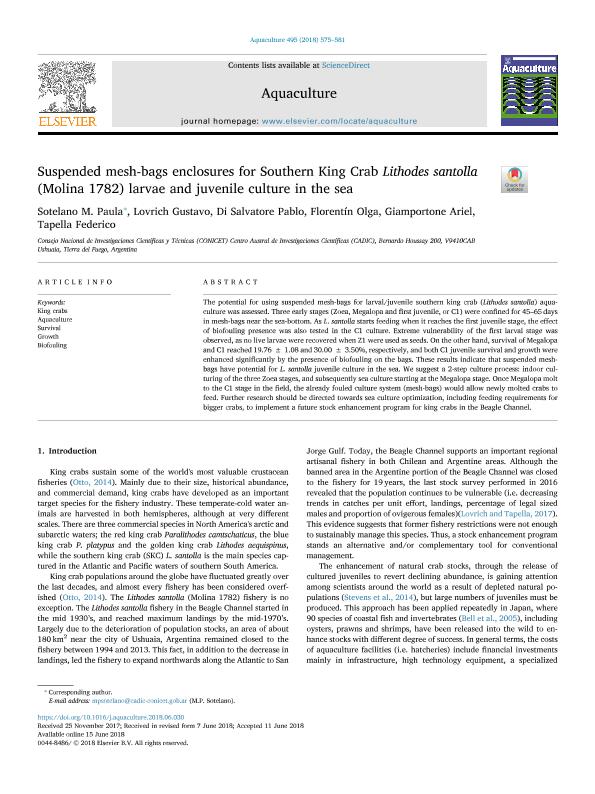Artículo
Suspended mesh-bags enclosures for Southern King Crab Lithodes santolla (Molina 1782) larvae and juvenile culture in the sea
Sotelano, María Paula ; Lovrich, Gustavo Alejandro
; Lovrich, Gustavo Alejandro ; Di Salvatore, Pablo
; Di Salvatore, Pablo ; Florentin, Olga Viviana
; Florentin, Olga Viviana ; Giamportone, Ariel Lujan
; Giamportone, Ariel Lujan ; Tapella, Federico
; Tapella, Federico
 ; Lovrich, Gustavo Alejandro
; Lovrich, Gustavo Alejandro ; Di Salvatore, Pablo
; Di Salvatore, Pablo ; Florentin, Olga Viviana
; Florentin, Olga Viviana ; Giamportone, Ariel Lujan
; Giamportone, Ariel Lujan ; Tapella, Federico
; Tapella, Federico
Fecha de publicación:
10/2018
Editorial:
Elsevier Science
Revista:
Aquaculture
ISSN:
0044-8486
Idioma:
Inglés
Tipo de recurso:
Artículo publicado
Clasificación temática:
Resumen
The potential for using suspended mesh-bags for larval/juvenile southern king crab (Lithodes santolla) aquaculture was assessed. Three early stages (Zoea, Megalopa and first juvenile, or C1) were confined for 45–65 days in mesh-bags near the sea-bottom. As L. santolla starts feeding when it reaches the first juvenile stage, the effect of biofouling presence was also tested in the C1 culture. Extreme vulnerability of the first larval stage was observed, as no live larvae were recovered when Z1 were used as seeds. On the other hand, survival of Megalopa and C1 reached 19.76 ± 1.08 and 30.00 ± 3.50%, respectively, and both C1 juvenile survival and growth were enhanced significantly by the presence of biofouling on the bags. These results indicate that suspended mesh-bags have potential for L. santolla juvenile culture in the sea. We suggest a 2-step culture process: indoor culturing of the three Zoea stages, and subsequently sea culture starting at the Megalopa stage. Once Megalopa molt to the C1 stage in the field, the already fouled culture system (mesh-bags) would allow newly molted crabs to feed. Further research should be directed towards sea culture optimization, including feeding requirements for bigger crabs, to implement a future stock enhancement program for king crabs in the Beagle Channel.
Palabras clave:
AQUACULTURE
,
BIOFOULING
,
GROWTH
,
KING CRABS
,
SURVIVAL
Archivos asociados
Licencia
Identificadores
Colecciones
Articulos(CADIC)
Articulos de CENTRO AUSTRAL DE INVESTIGACIONES CIENTIFICAS
Articulos de CENTRO AUSTRAL DE INVESTIGACIONES CIENTIFICAS
Citación
Sotelano, María Paula; Lovrich, Gustavo Alejandro; Di Salvatore, Pablo; Florentin, Olga Viviana; Giamportone, Ariel Lujan; et al.; Suspended mesh-bags enclosures for Southern King Crab Lithodes santolla (Molina 1782) larvae and juvenile culture in the sea; Elsevier Science; Aquaculture; 495; 10-2018; 575-581
Compartir
Altmétricas



